by Naomi | Mar 16, 2018 | Tools & Apps
My playlist is an eclectic collection of tools that help me approach my work as play. I love them so much, I want to share them with you!
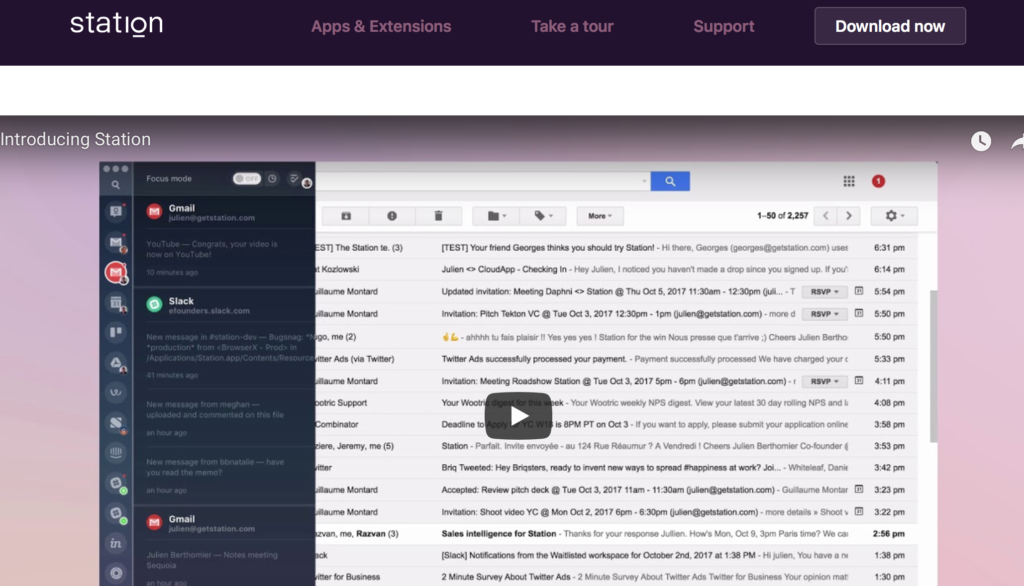
Object: Accessing my online tools on my desktop computer more easily.
What Didn’t Work: Trying to remember the apps I needed to open and keep tabs on, logging in and out, having tons of tabs open at the same time, taking tons of time to find my way from one tool to the one I needed next.
My Aha! Moment: I stumbled across Station accidentally, and nearly danced for joy. Imagine you could have a dashboard with all of your online tools collected in one streamlined toolbar. Then, add to that the ability to save specific windows within each of those tools. So, say on Google Drive you’re always visiting a couple pages. What if you had a tool that made saving those windows simple, and you could easily toggle between the windows you needed with no lost time navigating? Amazing, right?
Usually, I hang out with a tool for a while before I add it to my playlist, but this one is so good, I wanted to share it with you right away. If you use online apps such as Google drive, Buffer, Pinterest, Twitter, Facebook Business Manager, Airtable, Slack, Evernote, (or any number of others) this app is going to rock your world.
How I Play:
- I went through the tool list and added the tools I use often.
- I sorted the tools on the scroll bar so that the similar ones are together, and the most used ones are at the top.
- As I work, I’m adding pages to each tool to make navigation easier and easier as I go.
Player’s Notes:
- The set-up process is simple, but it does require logging into everything to get started. You’ll want to make sure you’re feeling patient.
- It’s tempting to set up everything perfectly right away. However, adding pages as you go is very easy, so I’d recommend setting your dashboard up on a basic level and then fine-tuning as you go.
- Right now, Station is free, but I can’t imagine that it will be forever. Be an early adopter!
Take it to the Next Level:
- Station has some tools to help you quiet notifications and can help you truly get into the zone. Play around with how you might use the tool to deepen your concentration and get deep work done.
by Naomi | Mar 6, 2018 | Creative Life
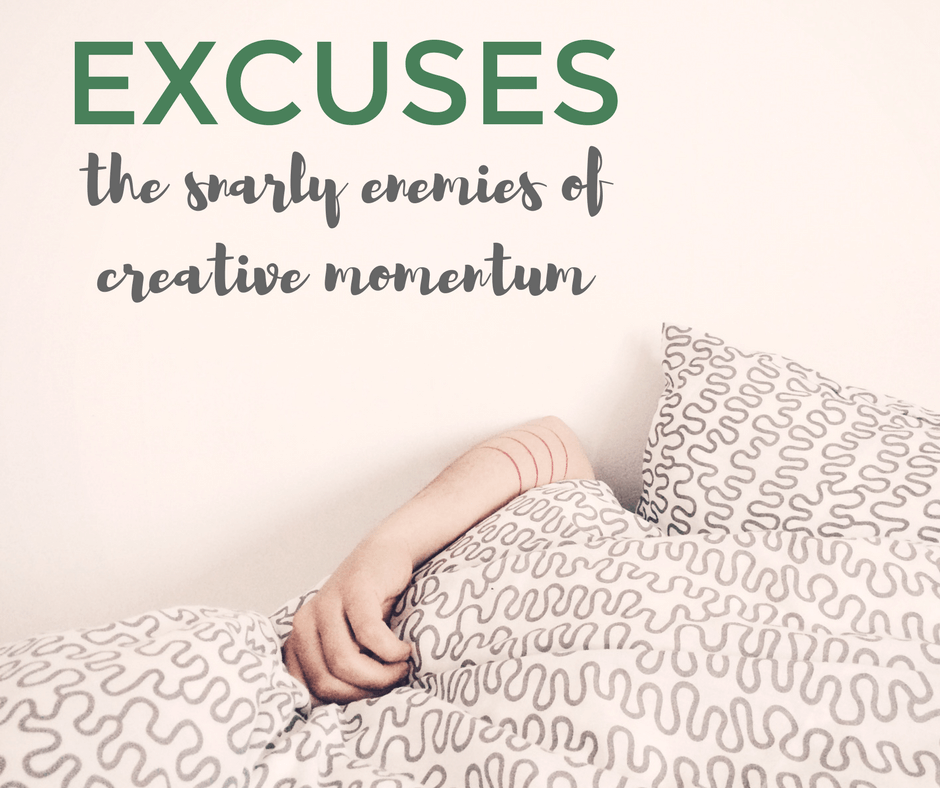
I’m not a fan of excuses.
And, not in a blow a whistle and shout, “Get to work!” kind of way. More in a roll-up-my-sleeves, experiment-until-you-figure-it-out kind of way.
Excuses are snarly enemies of momentum. They snap at our heels and grab for us with grubby little fingers, hoping to drag us into inertia quicksand. Once we’re sunk, wow is it difficult to scrabble our way free.
A large part of my job, working with educators, with students, with artists, with my team at Society of Young Inklings, is to glare excuses in the face and say, “Not on my watch.” So, it’s probably not surprising that I feel particularly grumpy when I wake to the sound of excuses throwing a dance party at the foot of my bed.
Here we are. It’s March 5, and my last blog post was on January 20. For the larger part of 2017, I posted once a month or so. Now, there are definitely reasons. For one, I’ve been posting more regularly over at Society of Young Inklings because we’re in the midst of a (very exciting) growth curve at our nonprofit for youth writers. Also, I’ve been hard at work backstage on larger creative projects that I can’t share just yet.
Still, to me, these reasons have the sharp scent of excuse to them.
Knowing that I mean to blog, and don’t, takes wind out of my sails every week. Over time, I prove to myself that I’m the sort of person who plans but doesn’t necessarily follow through. My confidence erodes. My optimism suffers. The excuses pole-vault from one area of my life to another and before I know it, my life’s rhythm is completely out of whack.
Today, I’d finally had enough. I decided to hop online and share a little of my thinking real-time. Maybe you’ve had situations like the one I’m in, where you realized that your expectations and your reality weren’t matching up. What did you do?
Here’s what I’m thinking.
- I could take an official break from the blog. This would be a reasonable strategy, and would send the excuses packing. Unfortunately, it would also mean I couldn’t blog, which is a problem. In the past few weeks, I’ve actually been prepping for a more regular editorial calendar. I’m looking forward to blogging regularly … I’m just not quite ready yet.
- I could set a launch date for my new approach and build toward it. While a date is also a deadline, I actually like the sound of this possibility. It gives me breathing room, and also a healthy dose of accountability.
- I could force myself to start today and carry on, posting once a week, rain or shine. But, you deserve my very best. My posts ought to rattle fresh creativity loose for you, or at the least, send you back to your projects with renewed enthusiasm. If I bully myself into blogging when I’m not ready, I fear I might inspire you to bully yourself, too. No, thank you.
- Or, I could decide to close down the blog. But, I love writing from my heart to yours. So, for me, that’s really not an option.
I may have found a solution in the possible launch date, but I want to explore how to make it a viable one for the long run. Because the truth is, my bandwidth for producing meaningful content will ebb and flow. As an author, book deadlines come before blog intentions. As a founder and Executive Director, the stability and health of Society of Young Inklings are also top priority. And beyond work commitments, I have health, family, friends, to name a few. And life isn’t always predictable.
Over the years, I’ve learned a lot of excuse-extermination strategies. Most often, I return to the simple question starter: “How might I…”
Step One: Craft a question to focus my attention tightly on the problem.
How might I be realistic, true to my priorities, realistic, and make an excuse-free commitment?
Step Two: Brainstorm options.
- Commit to post infrequently, maybe once a month.
- Repurpose old posts along with the new ones.
- Create some short-form post formats. Every post doesn’t have to be epic. (Readers appreciate short, too!)
Step Three: Choose an approach and experiment.
I think I’ll commit to starting the blog again on April 3. I’ll post on Tuesdays and possibly add a bonus post on Thursdays. Some posts will be small. I’m not going to demand perfection. If I’m in a busy season, I’ll show up on Tuesday and tell you so. It might just be a sentence or two. But what I learned writing this post, (and here’s what I hope might be applicable to you, too) is that even mid-process, our thoughts can be useful.
Are you battling excuses, too? Maybe it’s not a blog for you, but it’s a book, or a painting, or even an exercise routine. Would it help you to stop, ask yourself a focused “How might I …” question and brainstorm solutions?
It certainly gave me a fresh gust of wind in my sails.
Thank you. Knowing that you’re out there, living life, popping by the Writerly Play blog now and again for ideas and inspiration, means more to me than you likely know. Perspective, growth, clarity… I gain all of these and more by shaping my ideas on the page, and especially when I hear back from you. I love hearing what you see and notice and wonder. So, please. Always, always, feel free to reach out and share your experiences, too. Tag me on Facebook or Twitter, or comment below.
Tell me: What expectations do you have for yourself that you’re not sure work right now? How might you adjust those expectations to make life work better?
Or tell me: Have you met the excuse gremlins? What kind of havoc do they cause in your life?
by Naomi | Jan 20, 2018 | Creative Life
The wide-awake way that children’s authors view the world that never fails to inspire me. Here’s a dose of wisdom to inspire, stretch and most importantly, motivate you to keep collecting ideas. Where are they? Tiptoeing around your world, whispering to you, inviting you to follow and explore.

“But the sensibility of the writer, whether fiction or poetry, comes from paying attention. I tell my students that writing doesn’t begin when you sit down to write. It’s a way of being in the world, and the essence of it is paying attention.”
— Julia Alvarez
“I often have trouble falling asleep at night, so when I’m lying in bed I think up stories. That’s where I do a lot of my thinking. I also get a lot of ideas while I’m reading – sometimes reading someone else’s stories will make me think of one of my own.”
— Linda Sue Park
“Sometimes you have to stop trying to force it, walk away and let your subconscious show you the way. Fill up on life for a while.”
— J. K. Rowling
“Artists need to fill themselves to overflowing and give it all back.”
— E. B. Lewis

“You can make up your own story when you look at a photo.”
— Brian Selznick
“The main thing to do is pay attention. Pay close attention to everything, notice what no one else notices. Then you’ll know what no one else knows, and that’s always useful.”
— Jeanne DuPrau
“We cannot stay home all our lives, we must present ourselves to the world and we must look upon it as an adventure.”
— Beatrix Potter
“Maybe we are all cabinets of wonders.”
— Brian Selznick
I know, I know, I said ten quotes on collecting ideas … but I couldn’t help myself. I added a few extra.
“Take a step, breathe in the world, give it out again in story, poem, song, art.”
— Jane Yolen
“The city is like poetry; it compresses all life, all races and breeds, into a small island and adds music and the accompaniment of internal engines.”
— E. B. White
Collecting ideas is one of the cornerstone habits in the Writerly Play Attic. Curious to know more? Writerly Play a story-based lens to help you individualize, map and problem-solve the creative process.
If you’ve ever found yourself stuck and unsure what to do next, or if you crave a more trustworthy process for bringing your ideas to life but don’t want to feel trapped by a one-size-fits-all solution, I hear you. I hand-crafted Writerly Play because I needed it, and my students needed it, and my peers needed it. You don’t have to stumble around in the fog when you’re bringing a new, beautiful creation to life.
Want to give it a try? The first step is figuring out your creativity style.
And hey, do you have any favorite quotes on collecting ideas? Maybe yours are from children’s authors, or from someone else entirely. Please share! Share in the comment section below, or share and tag me on Facebook or Twitter. I’m always collecting new inspiration. I hope you are, too!
SaveSave
SaveSave
SaveSave
SaveSaveSaveSave
SaveSave
SaveSave
by Naomi | Jan 11, 2018 | Creative Life
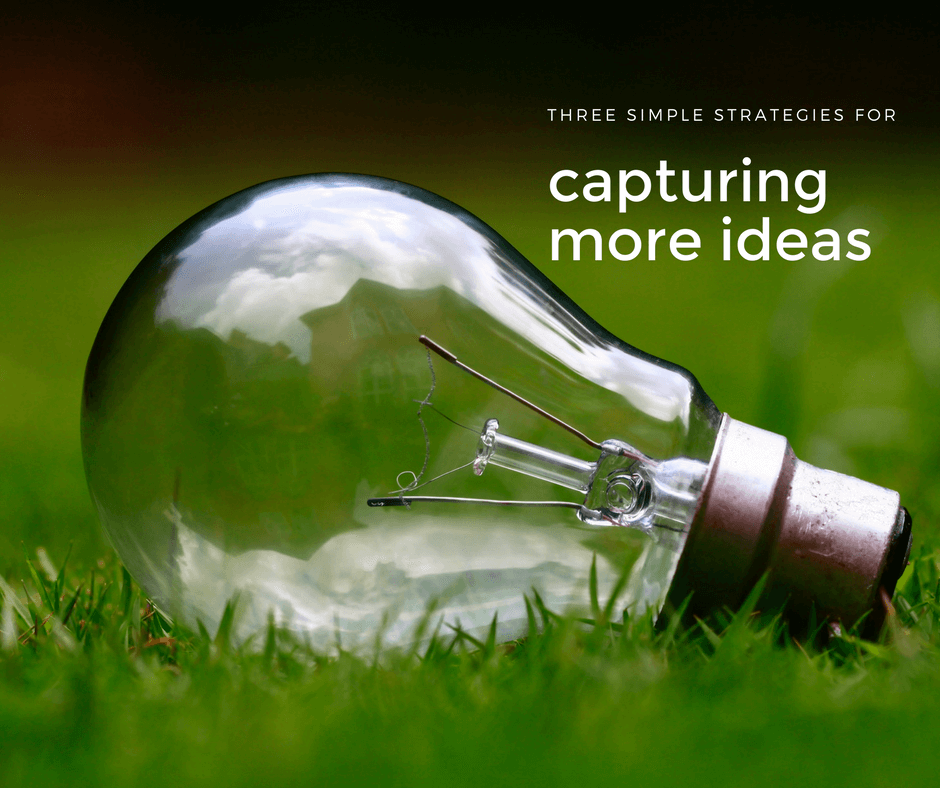
You have thousands, probably millions of ideas, I know you do. The trick is capturing them and keeping them somewhere convenient.
Why do we lose ideas?
Consider the key hook by the front door. Until we install it, our keys drift all over the house, refusing to be found when it’s time to dash out on an errand.
A key hook is such a simple, inexpensive solution to an everyday problem, a problem that wastes tons of time and plunges us into a ferociously terrible funk. Unfortunately, this simple life-hack eludes many of us multiple times in our lives.
The solutions for lost ideas are similarly easy to implement. I’ve collected three for you in this post, but my hope is that you’ll create even more of your own, based on how your life works and where your ideas tend to show up.
Popcorn Catch-All
Ideas are likely popping into your mind all day. Choose a simple, trustworthy place to keep them. Where you choose to keep them isn’t nearly as important as the key point: You have to choose a spot and stick to it. Try somewhere on your phone such as in an Evernote notebook, Google Keep, Day One, or in a small notebook you carry with you. The more you use it, the more valuable your catch-all becomes. When you need an idea, you’ll have a growing list of them.
Story of the Day
Every day, tons of things happen. First, there are tiny interactions with family, colleagues and friends. Then, there are mini-experiences such as an excellent cup of coffee, a particularly beautiful sunrise or the surprise scent of jasmine when you’re out on a run. Finally, there are the major moments that surprise, frustrate or excite you. Capture these life moments–the small and the large–by writing down one story per day. You can write a sentence, a paragraph, or a whole page. You can use a photo to tell most of the story. No matter how you format it, be intentional about noticing what happens to you and keeping track. Over time, you’ll have a collection of moments that helped you learn and grow, and that you can use in many different ways.
Post-Conversation Brain Dump
Whether it’s a meeting, a coaching session, a mastermind group brainstorm or manuscript feedback from a friend, that conversation gave you at least one idea. Make the most of your interactions by taking a minute or two afterward to write down a few thoughts. Use a template to speed up the thinking process. And don’t let perfect be the enemy of the good. You might not remember every single question you want to follow up on, but if you capture even a portion of your insights, that’s a portion more than you’d have if you’d let the day speed past without jotting them down.
It’s not about the hook.
Maybe when I mentioned a key hook, you thought, “I don’t use a hook, I use a bowl.” (Or something else entirely.) Whether you use a bowl or a hook or a pegboard doesn’t matter. The point is noticing that you have a little problem that can be solved in a simple way.
No matter how you choose to capture your ideas, make sure that you DO capture them. Create a little system for yourself, and notice how it pays off. Do you already have a pretty fabulous idea system? I’d love to hear about it! Tell us in the comments below, or tag me and share your ideas on Facebook or Twitter.
by Naomi | Dec 8, 2017 | Creative Life
… is one bite at a time.
Hopefully you don’t eat airplanes, but if you do (and even if you don’t), check out How to Eat an Airplane by my friend, Peter Pearson. Hilarious stuff. An excellent gift idea for nearly anyone on your list.
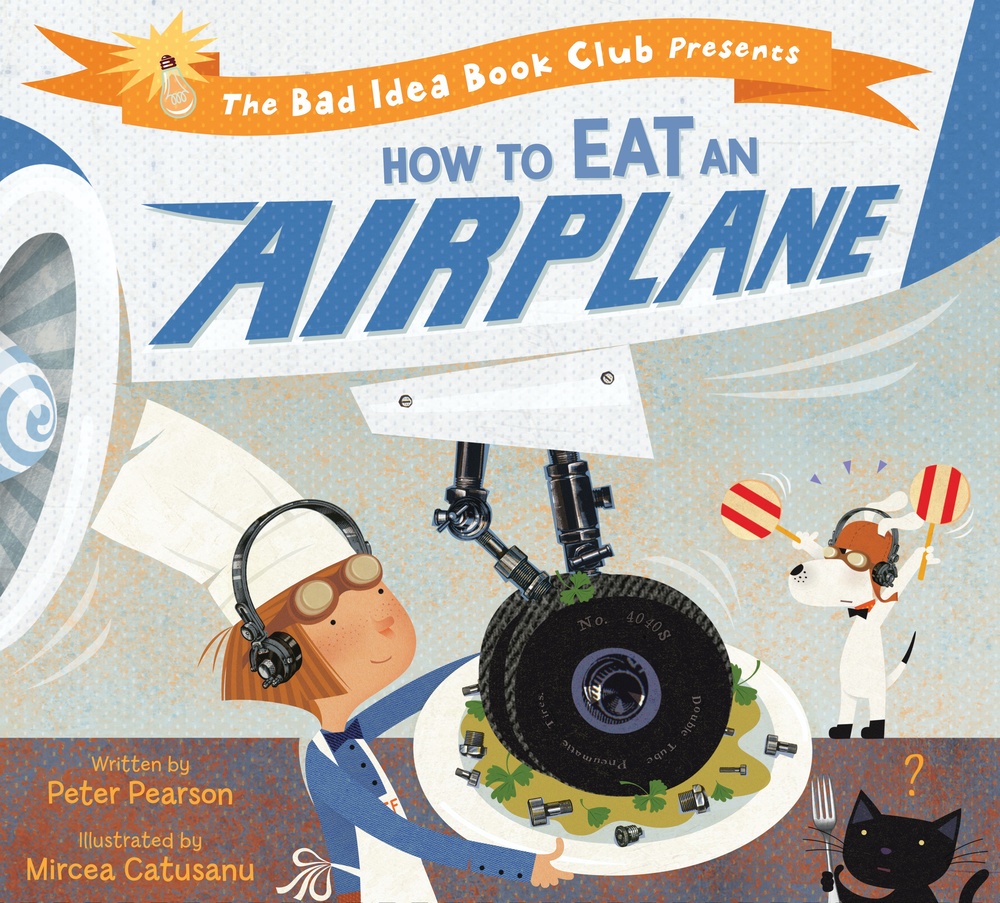
Honestly, though. This morning, I woke up to a list that included:
- Skeleton an online course
- Revise program launch marketing materials (emails, blog posts, etc.)
- Read twelve novels in progress and provide feedback
Those tasks were only three of about twenty items. Is anyone else’s life like this? No, I take that back. I know this kind of overwhelm is the norm for most of us.
Before you send me emails explaining how I should better manage my to-do list, I honestly have been working on planting my feet in reality and putting a better system into place. And even if it doesn’t appear true, based on the evidence above, I actually have been making progress.
The real topic I wanted to write about, though, isn’t to-do lists. I’ve been thinking about how to tackle enormous projects, especially when I have more than one of them on my list–which is always. I wear more than one hat, and that means having more than one project. Most artists are in my same boat.
I’ve thought a lot about systems and processes, but the thing that has mattered most is mindset. Specifically, the story I tell myself about how I’m doing. When I’m disheartened, I work slowly. I need breaks and chocolate. And then, because of the chocolate, I need naps. If I focus on what’s working, my brain fog clears, and I can see the next right step. Or, yes… I can take the next bite of the airplane.
Recently, November ended. If you’ve been following my blog, you know I committed to revising my novel for NaNoWriMo. And … I finished! Except, I didn’t finish exactly the way I pictured finishing. The last few chapters were summarized rather than drafted. Still, the novel is one cohesive piece, and so much progress was made. Now, I could tell myself I failed, because technically I didn’t write all the way to the end. Or, I can tell myself what’s actually more true, that I kept at it, that I did the work I needed to do, and that I sent it to someone for feedback at the just-right stage.
The point is, whether I call my effort a success or a failure is up to me. And since I gave the book my very best effort in the time I had to spend, I think that calling my work a success is more healthy than beating myself up. What’s more, allowing myself to feel proud of what I achieved, rather than obsessing on what is left to do, keeps me in motion.
That plane is still there, waiting to be eaten, after all.
If you’re in a similar place, juggling many projects … I’m guessing so many of you are … keep in mind that you can definitely review your workflow, focus, and find ways to work smarter. What may be even more powerful, however, is revising the story inside your head. Don’t let it run on autoplay. Be intentional about celebrating your successes.
And keep going. One day, you’ll wake up and it will be time for the last bite of that airplane. Until the next one shows up! You love challenges, after all, so make peace with the process. That’s where you’ll be most of the time.
by Naomi | Nov 14, 2017 | Creative Life
When I write collaboratively, or for hire, I storyboard a book ahead of time. The creative limitations push me to work within boundaries, and honestly, cause me to take fewer risks.
On the other hand, when I write a book of my heart, I usually choose a question that beguiles and enchants me, which refuses to let me go. I follow my curiosity, tumbling through the drafting process, allowing the characters to be more than actors in my master plot. I find myself being surprised, challenged, pushed to consider alternate perspectives. I end up with a messy draft, but the final product is always a more interesting and original novel.

Recently, while reading Creativity: Flow and the Psychology of Discovery and Invention, by Mihaly Csikszentmihalyi, I found that my experience is common to other creatives. One of the many insights the book shares is that often, smaller amounts of progress are made when a question is posed to a creative and he or she works within limitations. Larger leaps happen when the creative both defines AND resolves a question.
When I think about it, this reality makes sense. Once twenty people have identified the fact that we need a book that shows us what happens when x meets y… the eventual books written may end up having many similarities. However, if the question is one most of us hadn’t yet asked, the resulting book is likely to push us to think in startling new ways.
The reality of this in my own writing process is that revision feels like untangling a delicate chain. I find a starting place and work to loosen one knot, only to realize that I’ve created another. The line from beginning of project to end is not straight or predictable. And yet, the unpredictability of this approach, the joy of discovery, the fact that I learn and grow through the writing, makes the struggle worthwhile.
I believe the artist’s job is to spend time wrestling with questions. We aren’t required to have more answers than other people, but we do need to ask more questions. We also need to spend more time working through the questions. The more time invested, the more work that we can do. Through conversations with others, revision, reflection, and feedback, we become more of who we desire to be, and our work becomes more than what we, personally, could have made it.
Maybe it’s not the most efficient way of writing a book. However, for me, it’s the way to end up writing a meaningful book.
So, here are some questions for you. Why are we all in such a rush? What are we all missing, due to our impatience? What might be possible if we slowed down and learned to savor the process?
I’d love to hear about your revision process, and how you deal with that ticking inner clock. Share below, or tag me on Facebook or Twitter. Let’s find ways to take the time we need to make our very best work.
by Naomi | Nov 1, 2017 | Creative Life
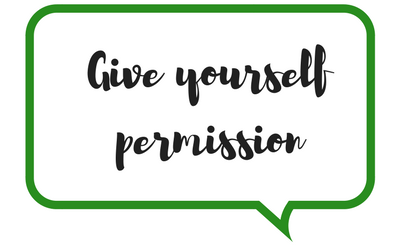
Today’s session was quick because the day was full.
When I started on my revision of this draft, I realized that my plot needed:
a. more humor
b. a subplot to drive the twists and turns of the story, in a nod to my source material, Midsummer Night’s Dream
c. more backstory
Many of the scenes have remained, but have required significant rewrites. Other scenes have needed to be drafted from the ground up. I’ve been working through the story sequentially, smoothing and drafting as I go.
In the past week or so, I’ve struggled to make progress. I’ve reached a section of scenes that haven’t yet been written. Up to this point, I’d been in deep analysis mode, weighing each word, action, reaction and gesture. Or, in other words, I’ve been deep in my Writerly Play Workshop. When I’m in this mode, I tend to be analytical in everything I do, planning my week, working on other projects, even in the various decisions I make through the day.
Today, I gave myself permission to close that door and head into my Writerly Play Studio. I was drafting a new scene, and I thought I’d play around a little bit with my character’s entrance. Sometimes the best way for me to move into a playful space is to put on my director hat and pretend I’m directing a scene. How would I want my actor to play this moment out? Often, I end up with a much more physical (and often, funny) scene. That happened today, livening up the beginning of my new chapter and giving me a running start. I haven’t finished the chapter yet–it’s going to be a challenging one–but I’m in the right mental space. I count that a win!
Onward to day two.
by Naomi | Oct 31, 2017 | Creative Life

NaNoWriMo is one of my favorite challenges of the year. Participating feels like giving myself an early Christmas present, the gift of allowing myself to prioritize my writing.
However, with November right around the corner, I realize that if I dropped everything to draft a new novel, I’d only be adding more crazy to my creative life. I don’t need more drafts of new novels. I need to buckle down and finish the one I’m working on.
I’m in the messy middle, with a manuscript that I’m now revise-drafting.
I wonder how many other writers find themselves in this place? For me, revision requires identifying problems, brainstorming solutions, drafting scene possibilities, making thousands of choices, and all the while, smoothing and refining as I go.
I really do wish I could use the stage-by-stage wheel that I sometimes see in elementary classrooms, where writers move clothespins labeled with their names from step to step: idea generation, drafting and on to revision. However, once I enter the revision phase, I need to bounce back and forth into all of those modes of thinking.
Wild bouncing may seem to appeal to a creative mind like mine…
It certainly is what comes most naturally. In actuality, bouncing can clog up momentum’s wheels. If I try to draft when my brain is deep in sentence-by-sentence analysis mode, drafting a few paragraphs can take hours. It truly does matter what I set out to do when I start a writing session, particularly when time is of the essence. Structure is absolutely needed, and yet, too much structure, and my creativity hides under the table. This conundrum–the need for structure that doesn’t suffocate–is the root of Writerly Play, the need that drove me to develop a model for mapping the creative process in the first place.
I’ve been doing a lot of research on the brain science of creativity, and have also spent a lot of time applying Writerly Play as a tool to help my students move forward with their projects. However, I’ve never documented how I use Writerly Play in my own revision process day-to-day. Aha! An opportunity to learn gain new insight.
Tomorrow, it will be November.
If you’re a writer (and in my opinion, we all have stories to tell, but that’s another topic for another day) I hope you’ve given yourself permission to prioritize your writing this month. Thousands of people participate, so you’ll be in good company. All you have to say is, “It’s NaNoWriMo, I’m writing,” and most people will understand why you need an hour or two a day to camp out in your favorite writing space. If they’ve never heard of NaNoWriMo, you can send them to NaNo’s website, and nine times out of ten, they’ll be amazed and impressed and ready to cheer you on.
I’ll be revising my draft, which will likely involve drafting 20,000 new words, and will surely involve dealing with the 60,000 words that I already have. I’m using the last day of the month as a firm deadline. On November 30, I will send my manuscript out to beta readers for feedback. No excuses.
As you can imagine, I’ll be a little busy this month, so you won’t see posts like the ones I normally write. However, I will post on the blog throughout the month about how I’m using Writerly Play as I revise. I’m curious to map a project in real time. I know I’ll learn a lot about how I think and create, and I can’t wait to look over the project at the end and see what insights I gain that might be helpful for others, too.
Ready? Let’s go write!
SaveSave
SaveSaveSaveSave
SaveSaveSaveSave
by Naomi | Oct 9, 2017 | Creative Life
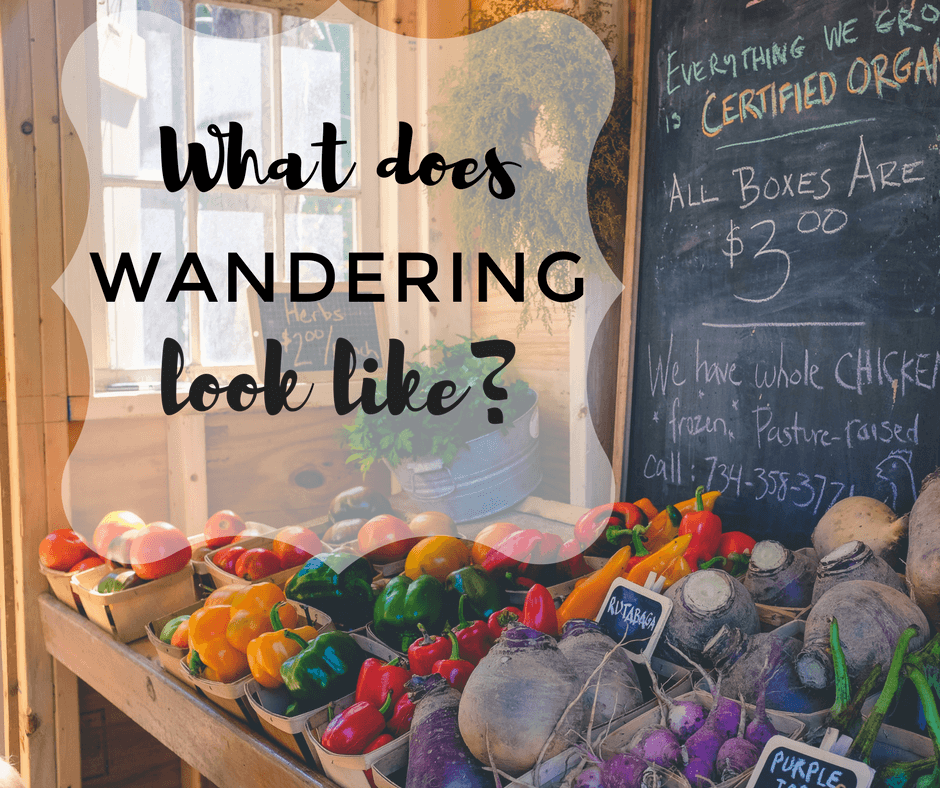
How do you know if something is a waste of time?
A common definition of “waste” is “to use or expend carelessly, extravagantly, or to no purpose. “ Synonyms for waste include squander, misspend, misuse, fritter away, or throw away. No one wants to squander or fritter away time.
But, ask a creative person how she spends her time, and if she’s being honest, she’ll describe work sessions punctuated by time spent in activities which are more difficult to define. Oddly, this time outside work sessions often creates a leap-frogging effect, vaulting work forward in a way that doesn’t happen when one is sitting down at a computer or with pencil and paper.
Unfortunately, the effect doesn’t work if you cut out the work sessions altogether. I’m not arguing that one should wander rather than work. But, there is something to the art of letting go and wandering.
For me, the wandering is literal.
I need to walk around in interesting environments. I need to touch contrasting textures of fabric and smell a variety of loose leaf teas. I need to see interesting patterns and shapes, and listen for contrasting tones of laughter. From the outside, I’m sure this wandering looks like a supreme waste of time. Why am I walking aimlessly, poking into stores, looking through baskets of random antiques, and heading home without buying anything?
I’m collecting. I’m filling up my sensory toolkit so that when I sit down to write, I have words and images and access to the feel of things. Too much time spent at my desk, and my senses dull. Fog settles over my brain and I might stare at my computer screen for ten minutes before coming up with a lackluster sentence. After puzzling over this fog, and how it showed up every now and then, I started to see the pattern.
And I started getting intentional about wandering.
What might speak to your senses?
[Tweet “Where might you wander to collect sights, smells and sounds to infuse your writing with life?”]
Don’t be afraid to carve out time to wander. If you need more encouragement, you’ll definitely enjoy Keri Smith’s intriguing invitation to the art of wandering: The Wander Society.
I’d love to know where you choose to wander! Share your ideas below, or tag me on Twitter or Facebook and let me know what you’re up to. I’m always collecting new ideas for where to wander next.
SaveSave
SaveSaveSaveSave
by Naomi | Oct 5, 2017 | Creative Life
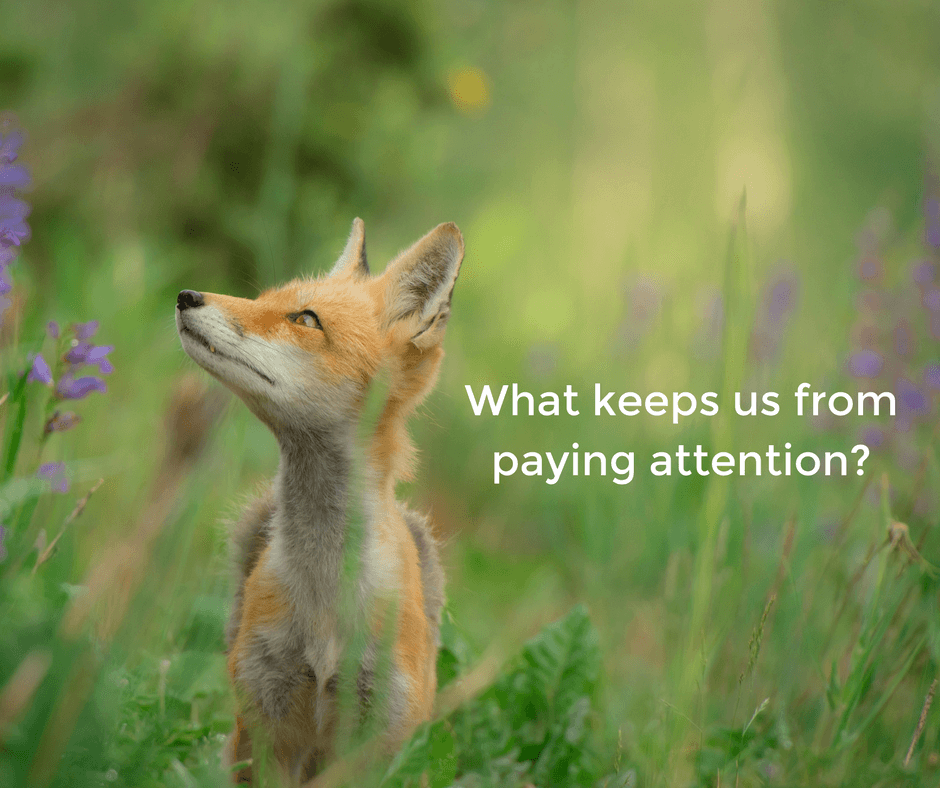
Too often
On my morning run
The neighborhood blurs
My mind far away
I stumble over
Unseen cracks in the sidewalk
Run straight into
Low-hanging branches
My mind circles
Rehearsing how I’ll do what’s next
Or reviewing what I did before
I’m in a tug of war—
Pulled forward
Tugged back
Or, my mind tumbles from request to request
Commitment to commitment
The way it was at summer camp
With campers in costumes
Set pieces scattered across the stage
Everyone calling, “Naomi, Naomi, Naomi!”
Between the words of one response
Another question is shoved
I can’t hear myself think
And no one gets their hoped for answer
We’re reminded about Deep Work
About The One Thing
About deleting, delegating and automating
But too often these spaces of clear and calm
Feel as impossible to reach as the Island of Long Ago and Far Away
Rather than a possible reality in the here and now
What keeps us from paying attention?
Our hearts.
They’re lured and captured and ransomed
By ideas of who we should be
Of what we feel responsible for
And where we wish we could be
(Anywhere but here)
In order to take back our attention
We have to take back our hearts
And hold them gently
Whispering the story
Of who we are
Untangling the true story
From the knots of should and ought to
Until we’re free












